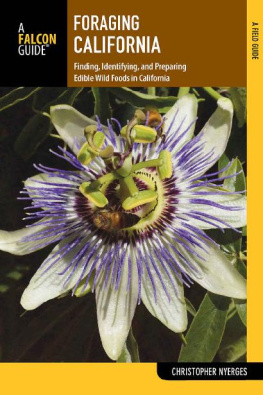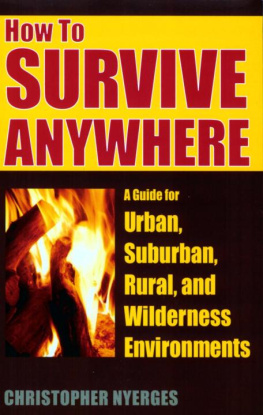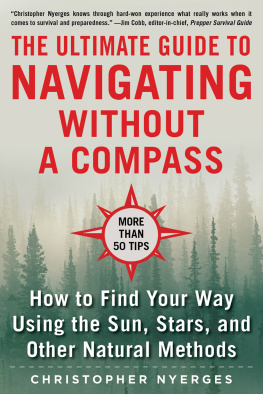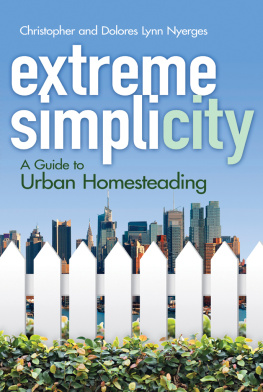

Copyright 2009 by Stackpole Books
Published by
STACKPOLE BOOKS
5067 Ritter Road
Mechanicsburg, PA 17055
www.stackpolebooks.com
All rights reserved, including the right to reproduce this book or portions thereof in any form or by any means, electronic or mechanical, including photocopying, recording, or by any information storage and retrieval system, without permission in writing from the publisher. All inquiries should be addressed to Stackpole Books, 5067 Ritter Road, Mechanicsburg, PA 17055.
Printed in the United States of America
10 9 8 7 6 5 4 3 2 1
First edition
Cover design by Caroline M. Stover
Library of Congress Cataloging-in-Publication Data
Nyerges, Christopher.
The self-sufficient home: going green and saving money / Christopher Nyerges.1st ed.
p. cm.
Includes .
ISBN-13: 978-0-8117-3558-2
ISBN-10: 0-8117-3558-3
1. Ecological houses. 2. Sustainable living. 3. DwellingsEnergy conservation. I. Title.
TH4860.N94 2009
640dc22
2009000448
eBook ISBN: 9780811741392
Contents
OTHER BOOKS BY CHRISTOPHER NYERGES
Extreme Simplicity: Homesteading in the City (with Dolores Lynn Nyerges)
How to Survive Anywhere
Guide to Wild Foods and Useful Plants
Enter the Forest
Testing Your Outdoor Survival Skills
Urban Wilderness: A Guidebook to Resourceful City Living
Wild Greens and Salads: A Cookbook
Guide to Wild Foods
Acknowledgments
I thank everyone who assisted me in the preparation of this bookall the folks whose names appear throughout these pages. I especially thank Glenn Forbes, who spent so much time making sure I had the technical aspects correct in the solar electricity section. Everyone was so eager to share their stories and to be a part of this book. I sincerely thank you all!
I also give special thanks to my wife, Dolores, who lived so much of this with me, and to Revve Weisz, who taught me what it is to think.
Foreword
Humans have walked this earth for over one million years. For practically all that time, we were hunter/gatherersa hardy and self-reliant bunch that lived in relative harmony with our surroundings. Ten thousand years ago, for reasons that are still largely a mystery, a cataclysmic change in human behavior occurred. We started to farm and settle down. The leisurely two- or three-day work week of the hunter/gatherer was replaced by the endless year-round toil of the farmer. Around the Mediterranean, the sturdy frame of the hunter shrank by over twelve inches during the transition to farming, and health declined precariously. Cities soon arose, and the egalitarian and generalist ways of the hunter/gatherer were replaced by rigid hierarchies and specialization of labor. As society grew more complex, its citizens became more interdependent, and a sense of control over individual destinies was drastically diminished. Nature, to which we were once so intimately connected, became something to be feared, subdued, and exploited. It is ironic that the perceived security of civilization often turns out to be much less stable in the face of a natural disaster than the hunter/gatherers way of life. The Bushmen, who once roamed across all of southern Africa, were long ago driven to one of the most inhospitable regions of the worldthe Kalahari Desertby more culturally advanced tribes. During a drought or other natural disaster, however, the Bushmen have a greater chance of survival than their farming Bantu neighbors. During the time that Native Americans were hunting bison, many regions of the American prairie were able to sustain a relatively large population density, yet the European settlers who displaced the natives had to abandon their farms within a few years.
Flash-forward to the early years of the twenty-first century. The Neolithic era has reached its zenith in the form of the nation-state. Across the globe, an exploding population has migrated to vast metropolitan areas. Communion with the natural world has become a rare event. Mankind finds itself surrounded by a man-made environment. A potted plant in the windowsill acts as surrogate for the forests and meadows of our past. All of this has taken place in the evolutionary blink of an eye. A mere ten thousand years of civilization is much too short of a time period to have any genetic influence on our hunter/gatherer brains. A zoo-born wolf will pace back and forth in its cage, longing for the forests and tundra it has never known. Similarly, many amongst us are pacing back and forth in our minds, longing for liberation from this Neolithic straitjacket, pining for Arcadia or Utopia, while an escalating frenzy of greed is laying waste to the world around us. Now, in these first years of the twenty-first century, things are coming to a head. Global warming, the despair of entire generations who have been displaced in their own countries, rampant financial malfeasancewe are all too familiar with the symptoms of our current crises. At the same time, there has never been a greater surge of innovation, with the promise of solutions to many of the problems facing us today. Alternative energy is rapidly approaching grid parity, when it will be able to compete in the open market with coal and nuclear energy production. Two of the most radical enablers of change in the history of mankind, the integrated circuit and the Internet, are altering every aspect of civilization with astonishing speed.
The current crisis is an opportunity to take stock of our lives. Circumstances may also require us to simplify our personal lives. Christopher Nyergess interest in wild foods, survival skills, and urban self-reliance has always been a practicalas well as a spiritualquest to live lightly on the land. Most of the people in the world are now city dwellers; this books emphasis on urban self-reliance therefore makes perfect sense. I have never reached anywhere near the level of self-reliance that Christopher and Dolores have, but I can wholeheartedly attest to the fact that even the tiniest adjustments can fill one with much satisfaction and help us regain in small increments a sense of purpose that is so chronically undermined by our consumer society. Every backyard vegetable bed, compost heap, or chicken coop, every home-grown kilowatt or normalized BTU, becomes an invitation to restore meaning to our lives.
Reflecting the urgency of our current predicament, this book puts more emphasis on the practical aspects of self-reliance than many of Christophers previous books. It forms a comprehensive guide of the current technology and know-how that is available for self-reliance in the city. I highly recommend it to people seeking to better themselves and their daily lives.
Carel Struycken
actor and permaculture advocate
Introduction
As energy costs continue to rise, more and more people are beginning to favor self-reliance. In the 1960s, one of the triggers for the back-to-the-earth movement was the perception that society had lost its roots and individuals had lost their sense of self-reliance. Many of the back-to-the-earth folks were driven by a commitment to the environment. They were concerned that modern lifestyles were ruining the earth. They wanted to be a part of the solution. Economics were not the driving force in their decisions to grow their own food or produce some of their power.
Next page













